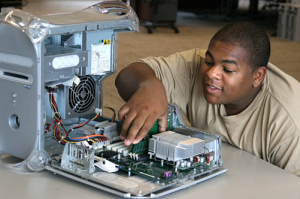(ThyBlackMan.com) What is pad cratering?
Pad cratering occurs when a copper termination pad separates from the PCB thus leaving a depression in the laminate. It can be a partial or complete disconnection from the board making it difficult to identify the fault; in a total separation, the solder remains on the component, making it look like the pad is in place. This problem puts pad cratering prevention at the top of PCB design.
Cratering is common on area array designs such as ball grids (BGAs) and is less with components which have many connections. The risk of cratering is increased by various processing parameters but is almost always caused by mechanical strain.
The strain from bends during manufacturing, testing, vibration during transport, or having connectors triggers cracks in the laminate. When the PCB bends, the board and components do not bend similarly thus the copper pads get ripped off the PCB because of the strain on the board.
What does cratering do to the PCB?
Expect inconsistent electrical failures from open circuits, especially between different boards from the same batch because cratering doesn’t always lead to a complete separation between the pad and the rest of the PCB making faults hard to identify. Odd performance due to increased resistance at the joint, intermittent contact, or completely open circuits will be an issue. Because of difficulty in identifying these faults extensive and destructive testing is employed to positively identify cratering as a fundamental problem with PCB performance.
Causes of pad cratering
- Factors in PCB board design and manufacturing process can cause cratering.
- Array area components face the greatest risk, but components with smaller trace pitch, larger size, or rigid packaging are also prone to cratering.
- The materials used on PCB can also lead to cratering such as board the thickness of the board and hardness of epoxy change board flexibility and increase the likelihood of cratering. Brittle laminates crack easily and cause cratering.
- While there are issues with both leaded and lead-free solders, the type of solder you use matters. Sn-Pb solder can handle almost twice the bending strain as SAC solder and stiffer lead-free alloys are more prone to cratering.
Preventing cratering
Cratering is difficult to detect thus making prevention the best way to deal with it. Plan your PCB layout carefully- don’t place large components or BGAs near edges or around connectors which may have to flex under pressure. Keep large heat sinks away to prevent repeated shrinking and expanding to strain the laminate or components.
Thermal mismatch during manufacturing is another thing to look out for; talk through the temperatures, ramp rates, and cooling times for all the materials in the PCB with your manufacturer to reduce strain due to CTE mismatch. Enquire about using copper needles for better adhesion to the laminate even though it will reduce electrical performance a little.
Lastly, handle your boards with care – avoid repeated vibration and do not drop the boards which can cause more damage than cratering.
Staff Writer; Gary Short

















Leave a Reply